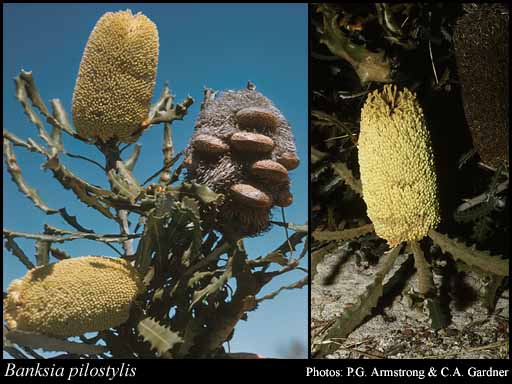- Reference
- J.Roy.Soc.Western Australia 47:57 (1964)
- Conservation Code
- Not threatened
- Naturalised Status
- Native to Western Australia
- Name Status
- Current
Much-branched, non-lignotuberous shrub, 0.6-4 m high. Fl. green-yellow/orange-brown, Oct to Dec or Jan. White or grey/yellow sand, sandy loam. Sandplains, often in swampy depressions.

Scientific Description
Shrubs, 1.8-4 m high; branchlets hairy. Leaves petiolate, alternate, 75-140 mm long, 5-15 mm wide, hairy; petiole 15-20 mm long; lamina flat, more or less the same width throughout, once divided, pinnately divided, shallowly divided, teeth distinctly pointing towards the apex, with 12-23 lobes on each side, the margins revolute. Inflorescences tomentose (with matted or tangled, soft, woolly hairs) or villous (with soft, shaggy, weak and straight hairs), yellow, hairy. Perianth 18-22 mm long, hairy, all over, limb apex hirsute (with long, rough and coarse hairs), without awns; pistil 21-25 mm long, curved, style hairy. Follicles glabrous or hairy, tomentose (with matted or tangled, soft, woolly hairs), elliptic, 22-35 mm long. Flowers in January, October, November or December. Occurs in the South-west (SW) Botanical Province(s), in the Mallee (MAL) or Esperance Plains (ESP) IBRA subregion(s).
Distribution
- IBRA Regions
- Esperance Plains, Mallee.
- IBRA Subregions
- Eastern Mallee, Fitzgerald, Recherche.
- IMCRA Regions
- WA South Coast.
- Local Government Areas (LGAs)
- Esperance, Ravensthorpe.